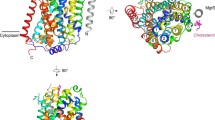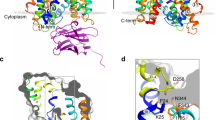Abstract
The uptake of l-arginine into mouse peritoneal macrophages can be inhibited by numerous amino acids and derivatives. Kinetic studies showed an almost entirely competitive inhibition for both cationic and neutral amino acids and derivatives suggesting that the comparison of their binding specificity by using a quantitative structure-activity relationship (QSAR) study is reasonable. The properties of the most efficient inhibitors were the following: the length of the aliphatic side chain, a general structural similarity to l-arginine (>0.79), cationic character, l-configuration, the presence of an α-amino group (with a mean pKa of 9.41), the van der Waals volume (mean 225 Å3) and a low logP value (mean: −2.99). The significance of four other descriptors (neutral character, presence and the pKa of an α-carboxyl group, and the presence of a modified guanidino group) is much lower. Similar results were obtained for the hCAT-1 cell line, but the significance of the descriptors was slightly different. The l-configuration, van der Waals volume, the low logP value and the length of aliphatic side chain were the most significant, while the pKa value of the side chain (mean pKa = 11.6) was found to be more important than that of the α-amino group. In addition, the general similarity to l-arginine, the presence of an amino group in the terminal position of the side chain (Orn, Lys) and the basic character were significant descriptors, while the significance of the acidity is negligibly low. As a final conclusion, the following descriptors were found to be important generally for the cationic transporters: the van der Waals volume, hydrophobicity (log P); l-configuration; the size of the side chain; the general similarity to l-arginine; the presence of an α-amino group; the general basicity of the molecule; the pKa values of the α-amino group (in macrophages) or that of the side chain (in CAT-1 cells). These descriptors can be regarded as the general structurally important binding characteristics of the cationic amino transporters.


Similar content being viewed by others
Abbreviations
- ANN:
-
Artificial neural network
- ANOVA:
-
Analysis of variances between groups
- CAT:
-
Cationic amino acid transporter
- HBSS:
-
Hank’s buffered salt solution
- NOS:
-
Nitric oxide synthase
- PBS:
-
Phosphate buffered saline
- QSAR:
-
Quantitative structure–activity relationship
References
3DNET4 W (2002) Vichem Ltd., Budapest, Hungary
ACD/Labs (2002) Ver. 6.0, Advanced Chemistry Development Inc. Toronto
Baydoun AR, Bogle RG, Pearson JD, Mann GE (1994) Discrimination between citrulline and arginine transport in activated murine macrophages: inefficient synthesis of NO from recycling of citrulline to arginine. Br J Pharmacol 112:487–492
Baydoun AG, Mann GE (1994) Selective targeting of nitric oxide synthase inhibitors to system y + in activated macrophages. Biochem Biophys Res Commun 200:726–731
Bogle RG, Baydoun AR, Pearson JD, Moncada S, Mann GE (1992) l-arginine transport is increased in macrophages generating nitric oxide. Biochem J 284:15–18
Bradford MM (1976) A rapid and sensitive method for the quantitation of microgram quantities of protein utilizing the principle of protein-dye binding. Anal Biochem 72:248–254
Closs EI (1996) CATs, a family of three distinct mammalian cationic amino acid transporter. Amino Acids 11:193–208
Closs EI, Basha FZ, Habermeier A, Förstermann U (1997) Interference of L-arginine analogues with L-arginine transport mediated by the y + carrier hCAT-2B. Nitric Oxide 1:65–73
Closs EI, Scheld JS, Sharafi M, Forstermann U (2000) Substrate supply for nitric-oxide synthase in macrophages and endothelial cells: role of cationic amino acid transporters. Mol Pharmacol 57:68–74
Closs EI, Simon A, Vekony N, Rottman A (2004) Plasma membrane transporters for arginine. J Nutr 134:2752S–2759S
Closs EI, Boissel JP, Habermaier A, Rotmann A (2006) Structure and function of cationic amino acid transporters (CATs). J Membrane Biol 213:67–77
Currie GA (1978) Activated macrophages kill tumour cells by releasing arginase. Nature 273:758–759
Erős D, Kövesdi I, Őrfi L, Takács-Novák K, Acsády Gy, Kéri Gy (2002) Reliability of logP predictions based on calculated molecular descriptors: a critical review. Curr Med Chem 9:1819–1829
Flodstrom M, Chen MC, Smismans A, Schuit F, Pipeleers DG, Eizirik DL (1999) Interleukin 1beta increases arginine accumulation and activates the citrulline-NO cycle in rat pancreatic beta cells. Cytokine 11:400–407
Hansch C, Bjorkroth JP, Leo A (1987) Hydrophobicity and central nervous system agents: on the principle of minimal hydrophobicity in drug design. J Pharm Sci 76:663–687
Hey C, Boucher JL, Vadon-Le Goff S, Ketterer G, Wessler I, Racké K (1997) Inhibition of arginase in rat and rabbit alveolar macrophages by Nω-hydroxy-D, l-indospicine, effects on d-arginine utilization by nitric oxide synthase. Br J Pharmacol 121:395–400
Hosokawa H, Sawamura T, Kobayashi S, Ninomiya H, Miwa S, Masaki T (1997) Cloning and characterization of a brain-specific cationic amino acid transporter. J Biol Chem 272:8717–8722
Hrabák A, Bajor T, Temesi Á (1994a) Comparison of substrate and inhibitor specificity of arginase and nitric oxide (NO) synthase for arginine analogues and related compounds in murine and rat macrophages. Biochem Biophys Res Commun 198:206–212
Hrabák A, Idei M, Temesi Á (1994b) Arginine supply for nitric oxide synthesis and arginase is mainly exogeneous in elicited murine and rat macrophages. Life Sci 55:797–805
Hrabák A, Bajor T, Temesi Á (1996) Computer-aided comparison of the inhibition of arginase and nitric oxide synthase in macrophages by amino acids not related to arginine. Comp Biochem Physiol 113B:375–381
Inoue Y, Bode BP, Beck DJ, Li AP, Bland KI, Souba WW (1993) Arginine transport in human liver. Characterization and effects of nitric oxide synthase inhibitors. Ann Surg 218:350–362
Ito K, Groudine M (1997) A new member of the cationic amino acid transporter family is preferentially expressed in adult mouse brain. J Biol Chem 272:26780–26786
Kakuda DK, Sweet MJ, Mac Leod CL, Hume DA, Markovich D (1999) CAT2-mediated l-arginine transport and nitric oxide production in activated macrophages. Biochem J 340:549–553
Labute P (1998) MOE LogP(Octanol/Water) Model. unpublished. Source code in MOE ($MOE/lib/svl/quasar.svl/q_logp.svl)
Lehninger AL, Nelson DL, Cox MM (1993) Principles of biochemistry, 2nd edn edn. Worth Publisher, New York, p 914
MacLeod CL, Kakuda DK (1996) Regulation of CAT: cationic amino acid transporter gene expression. Amino Acids 11:171–191
Manner CK, Nicholson B, MacLeod CL (2003) CAT2 arginine transporter deficiency significantly reduces iNOS-mediated NO production in astrocytes. J Neurochem 85:476–482
Marletta MA (1994) Approaches toward selective inhibition of nitric oxide synthase. J Med Chem 37:1899–1907
Martin L, Comalada M, Marti L, Closs EI, MacLeod CL, Martin del Rio R, Zorzano A, Modolell M, Celada A, Palacin M, Bertran J (2006) Granulocyte-macrophage colony-stimulating factor increases l-arginine transport through the induction of CAT2 in bone marrow-derived macrophages. Am J Physiol Cell Physiol 290C:1364–1372
MOE 2006.08 Copyright (c) 1997–2006 Chemical Computing Group Inc
Moncada S, Palmer RMJ, Higgs EA (1991) Nitric oxide: physiology, pathophysiology, and pharmacology. Pharmacol Rev 43:109–142
Nicholson B, Manner CK, Kleeman J, MacLeod CL (2001) Sustained nitric oxide production in macrophages requires the arginine transporter CAT2. J Biol Chem 276:15881–15885
Rotmann A, Strand D, Martiné U, Closs EI (2004) Protein kinase C activation promotes the internalization of the human cationic amino acid transporter hCAT-1. J Biol Chem 279:54185–54192
Rotmann A, Vékony N, Gassner D, Niegisch G, Strand D, Martiné U, Closs EI (2006) Activation of classical protein kinase C reduces the expression of the human cationic amino acid transporter hCAT-3 in the plasma membrane. Biochem J 395:117–123
Rotmann A, Simon A, Martiné U, Habermeier A, Closs EI (2007) Activation of classical protein kinase C decreases transport via systems y + and y + L. Am J Physiol Cell Physiol 292:2259–2268
Sato H, Fujiwara M, Bannai S (1992) Effect of lipopolysaccharide on transport and metabolism of arginine in mouse peritoneal macrophages. J Leukoc Biol 52:161–164
Schmidt K, Klatt P, Mayer B (1994) Uptake of nitric oxide synthase inhibitors by macrophage RAW 264.7 cells. Biochem J 301:313–316
Simmons WS, Closs EI, Cunningham JM, Smith TW, Kelly RA (1996) Cytokines and insulin induce cationic amino acid transporter (CAT) expression in cardiac myocytes. J Biol Chem 271:11694–11702
Talaue MT, Venketaraman V, Hazbon MH, Peteroy-Kelly M, Seth A, Colangeli R, Alland D, Connell ND (2006) Arginine homeostasis in J774.1 macrophages in the context of Mycobacterium bovis BCG infection. J Bacteriol 188:4830–4840
Vekony N, Wolf S, Boissel JP, Gnauert K, Closs EI (2001) Human cationic amino acid transporter hCAT-3 is preferentially expressed in peripheral tissues. Biochemistry 40:12387–12394
White MF (1985) The transport of cationic amino acids across the plasma membrane of mammalian cells. Biochim Biophys Acta 822:355–374
Wildman SA, Crippen GM (1999) Prediction of physiochemical parameters by atomic contributions. J Chem Inf Comput Sci 39:868–873
Wolf S, Janzen A, Vékony N, Martiné U, Strand D, Closs EI (2002) Expression of solute carrier 7A4 (SLC7A4) in the plasma membrane is not sufficient to mediate amino acid transport activity. Biochem J 364:767–775
Yeramian A, Martin L, Arpa L, Bertran J, Soler C, McLeod C, Modolell M, Palacin M, Lloberas J, Celada A (2006) Macrophages require distinct arginine catabolism and transport systems for proliferation and for activation. Eur J Immunol 36:1516–1526
Acknowledgments
The authors wish to express their thanks to dr. Gergely Keszler for the helpful discussion, to Miss Judit Szabó and Mr. Antal Holly for their skillful technical assistance. The contribution of the laboratory of Prof. Ellen I. Closs (University of Mainz, Germany) by providing CAT-1 cells is also highly appreciated. The work was supported by the grants of the Hungarian Ministry of Welfare (ETT 556/2006) and of the National Foundation of Scientific Research (OTKA 043075).
Author information
Authors and Affiliations
Corresponding author
Rights and permissions
About this article
Cite this article
Erős, D., Őrfi, L., Csuka, I. et al. Binding specificity of the l-arginine transport systems in mouse macrophages and human cells overexpressing the cationic amino acid transporter hCAT-1. Amino Acids 36, 483–492 (2009). https://doi.org/10.1007/s00726-008-0106-x
Received:
Accepted:
Published:
Issue Date:
DOI: https://doi.org/10.1007/s00726-008-0106-x




